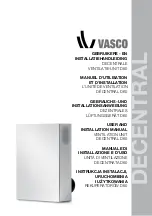
Page 19
WARRANTY
(See insert for more information)
Motor has a 5-Year replacement product warranty. This is a change over warranty. The consumer is responsible
for any charges associated with removal of the faulty unit and installation of the new unit. The customer is also
responsible for any freight charges incurred in the change over process.
Disclaimer
Under our policy of continuous product development, product specifications may change without notice.
Prospective purchasers should therefore check with the retailer to ensure this publication correctly describes
the products being offered for sale. All information supplied is to be used for general reference purposes only
and is on the understanding that Schweigen Home Appliances will not be liable for any loss, liability or damage
of whatever kind arising as a result of any reliance upon such information. All pictures used in the guide are for
illustrative purposes only.
9. Warranty / Disclaimer
Calling the Technical Assistance Service Hotline
In the event that the failure is not due to the faults mentioned in Trouble Shooting,
contact Customer Service.
In Australia,
Customer Service 1300 881 693
In New Zealand,
Customer Service 0800 200 510
Lodging an online Service Request
In the event that failure is not due the reason/s in the trouble shooting section, you can lodge
an online Service Request.
To lodge a Service Request, visit our website www.schweigen.com.au/pages/support/service-warranty
and click on the link to download the service request form.
A service request will require the following information:
• The purchase date
• The rangehood model and motor type
• The rangehood serial number or batch number (this number is on a sticker inside the rangehood)
• A copy of the purchase receipt (without a receipt your service request cannot be processed)
Faulty Installation
It is not the responsibility of Schweigen Home Appliances to rectify any incorrect installations. A service call
out fee will be charged for any Schweigen technician that attends a call, whereby it is established that the
fault is due to an incorrect installation or non-manufacturing fault. Should the appliance be installed in such
a way that the service agent is unable to gain access to the appliance, the person/s who own the premises
where the appliance resides — will be responsible to provide access to the appliance at their expense.


































